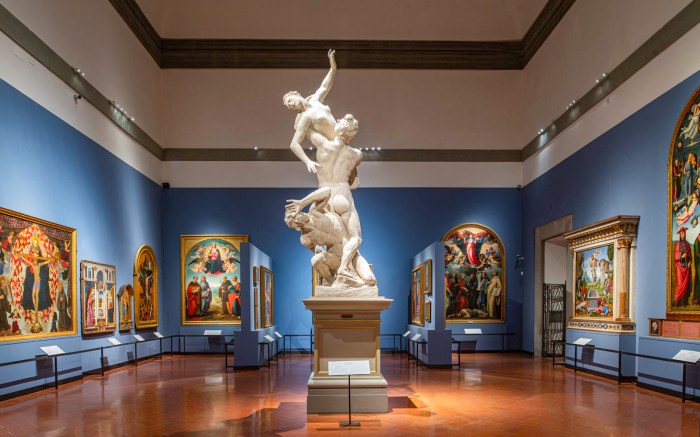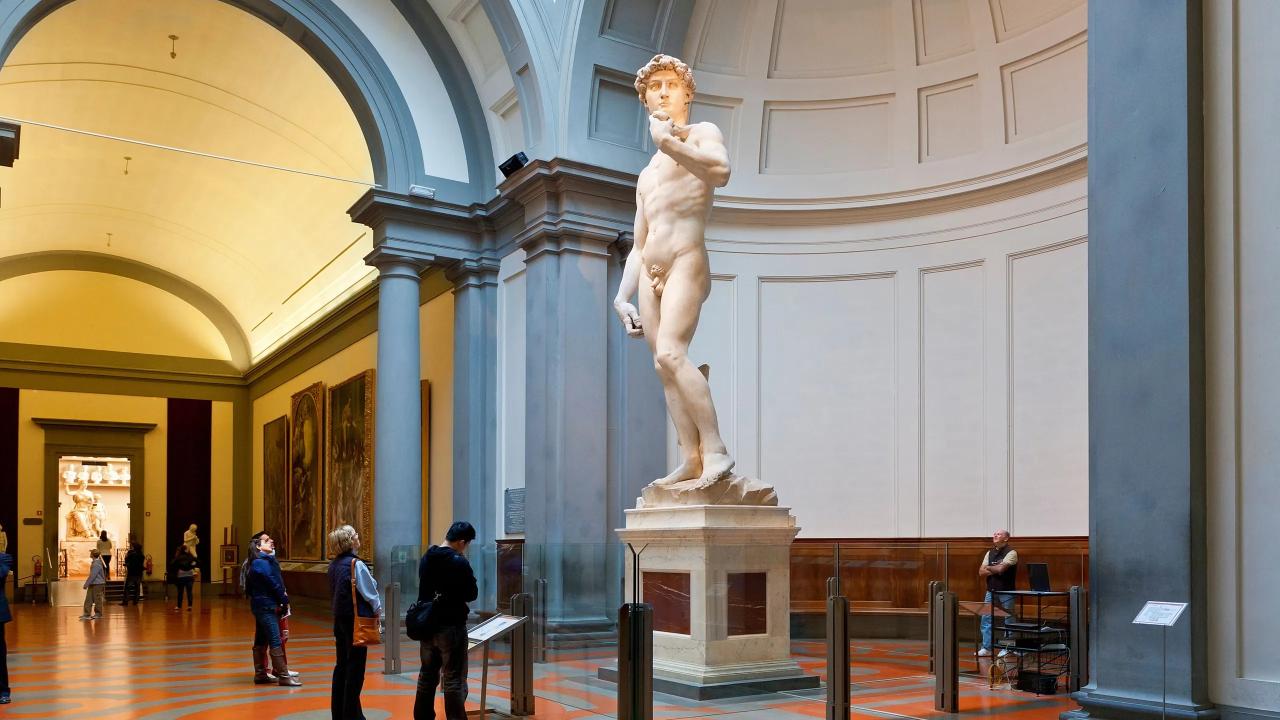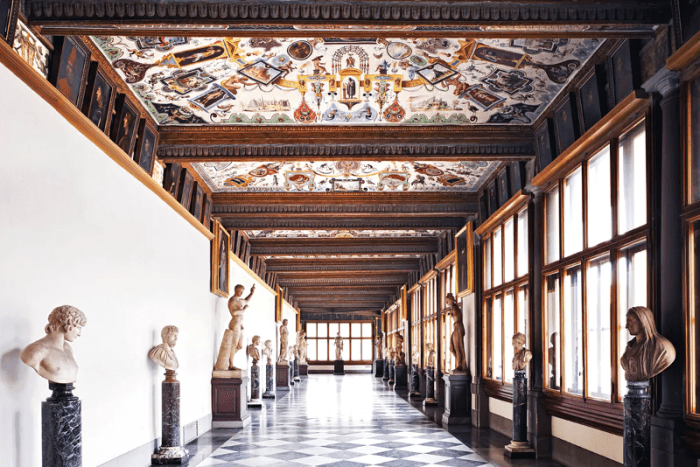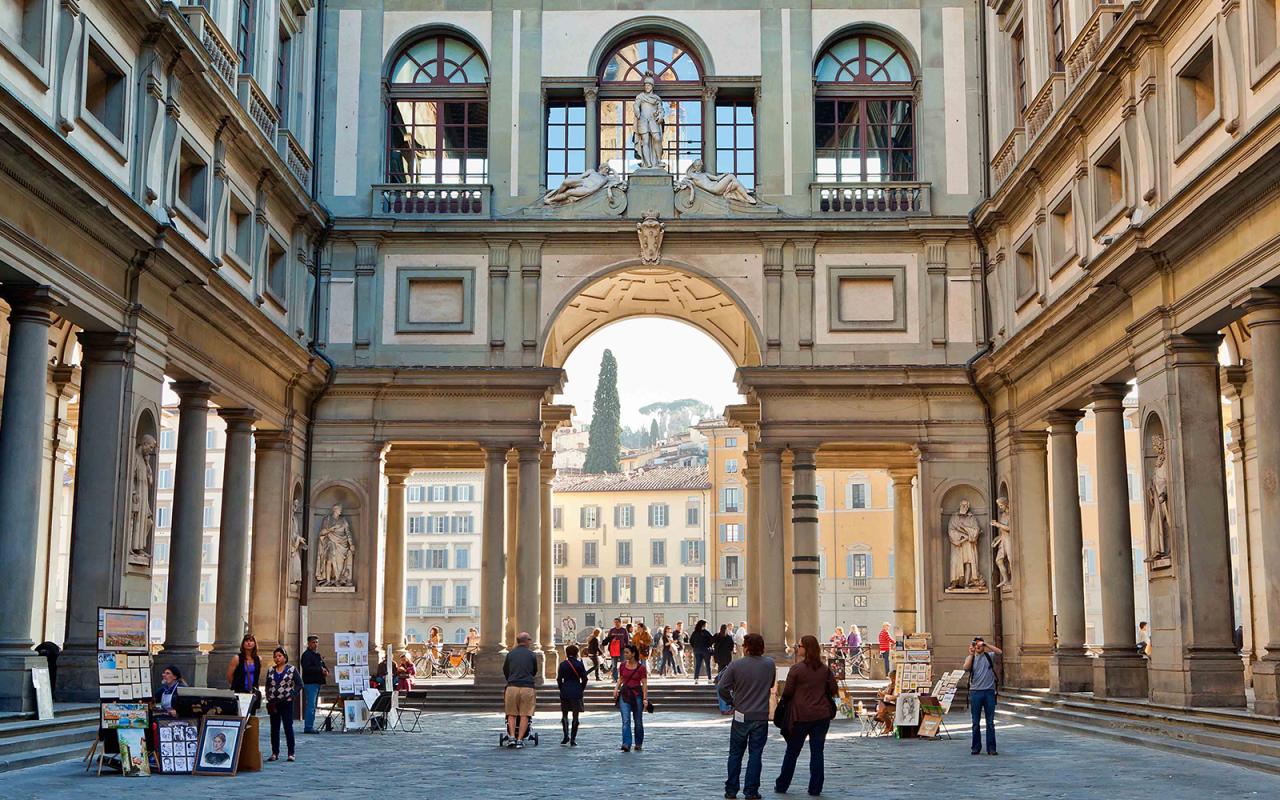Immerse yourself in the artistic wonders of Florence’s Accademia Gallery, a renowned institution that houses masterpieces from the Renaissance era and beyond. From Michelangelo’s iconic David to captivating paintings and sculptures, this gallery offers a captivating journey through the annals of art history.
As you explore the Accademia Gallery, you’ll encounter a diverse collection that showcases the genius of renowned artists such as Michelangelo, Leonardo da Vinci, and Sandro Botticelli. Each masterpiece tells a story, inviting you to delve into the techniques, styles, and historical context that shaped these works of art.
History and Significance of the Accademia Gallery
The Accademia Gallery in Florence, Italy, is a renowned art museum that houses a remarkable collection of paintings, sculptures, and drawings from the Florentine Renaissance. Its origins can be traced back to the 14th century when the Accademia delle Arti del Disegno (Academy of the Arts of Drawing) was founded by a group of artists, including Giorgio Vasari and Michelangelo. The academy aimed to promote the study and practice of the arts and established a collection of works by its members.
Evolution of the Gallery
Over the centuries, the academy’s collection grew significantly through donations, purchases, and bequests. In the 16th century, the Grand Duke of Tuscany, Cosimo I de’ Medici, expanded the collection and established the Uffizi Gallery as the primary repository for the city’s art treasures. However, some of the most important works remained at the Accademia, including Michelangelo’s “David” and “Pietà Bandini.”
The Accademia Gallery is a must-see for art enthusiasts, showcasing masterpieces like Michelangelo’s David. To enhance your visit, consider reading luxury travel tips for insider recommendations on accommodations and dining. Immerse yourself in the beauty of the Accademia Gallery, where art and history intertwine.
In the 19th century, the Accademia Gallery was officially established as a public museum. It underwent extensive renovations and expansions, culminating in the construction of a new wing in 1982 to accommodate the growing collection. Today, the Accademia Gallery is one of the most visited museums in Florence and a must-see destination for art enthusiasts worldwide.
Significance of the Gallery
The Accademia Gallery holds a significant place in the cultural and artistic landscape of Florence and the world. Its collection of Renaissance masterpieces, particularly Michelangelo’s “David,” has made it an iconic destination for art lovers. The gallery also plays a vital role in preserving and promoting the legacy of Florentine art and artists, inspiring generations of artists and scholars.
Masterpieces of the Accademia Gallery

The Accademia Gallery is home to an impressive collection of masterpieces, showcasing the talent and innovation of some of the greatest artists of the Italian Renaissance. These works span a wide range of artistic techniques, styles, and historical contexts, offering a comprehensive overview of the artistic achievements of this period.
David by Michelangelo
Michelangelo’s David is undoubtedly the most iconic masterpiece in the Accademia Gallery. Carved from a single block of marble, the colossal statue depicts the biblical hero David in the moments before his battle with Goliath. Michelangelo’s masterful use of chiaroscuro and contrapposto creates a sense of movement and tension that is both awe-inspiring and captivating. The statue is a testament to Michelangelo’s unparalleled skill as a sculptor and his profound understanding of human anatomy.
Pietà Bandini by Michelangelo
Another masterpiece by Michelangelo, the Pietà Bandini is a moving depiction of the Virgin Mary cradling the body of her son, Jesus Christ. Carved from marble, the sculpture is characterized by its emotional intensity and the delicate, lifelike rendering of the figures. The Pietà Bandini showcases Michelangelo’s mastery of the sfumato technique, which creates a soft, ethereal effect by blending colors and tones.
Madonna and Child with St. Anne by Leonardo da Vinci
Leonardo da Vinci’s Madonna and Child with St. Anne is a prime example of his innovative use of sfumato and atmospheric perspective. The painting depicts the Virgin Mary and her mother, St. Anne, with the infant Jesus in their arms. The figures are arranged in a pyramidal composition, with the Virgin Mary’s gaze meeting the viewer’s, creating a sense of intimacy and connection. The background landscape is rendered with meticulous detail, using Leonardo’s trademark atmospheric perspective to create a sense of depth and recession.
The Deposition by Botticelli
Sandro Botticelli’s The Deposition is a poignant depiction of the mourning of Christ after his crucifixion. The painting is characterized by its rich, vibrant colors and the expressive gestures of the figures. Botticelli’s use of linear perspective creates a sense of depth and drama, while the figures’ emotional expressions convey the depth of their grief and sorrow.
The Adoration of the Magi by Filippino Lippi
Filippino Lippi’s The Adoration of the Magi is a large-scale painting that depicts the three wise men presenting gifts to the infant Jesus. The painting is known for its intricate details, rich colors, and the inclusion of numerous figures in the background. Lippi’s use of perspective creates a sense of depth and grandeur, while the figures’ elaborate costumes and gestures convey the splendor of the event.
The Battle of Cascina by Michelangelo, Accademia gallery
Michelangelo’s The Battle of Cascina is a preparatory drawing for a fresco that was never completed. The drawing depicts a scene from the Battle of Cascina, a historical event that took place in 1364. Michelangelo’s masterful use of line and shading creates a sense of movement and energy, capturing the chaos and violence of the battle. The drawing is a testament to Michelangelo’s exceptional draftsmanship and his ability to convey complex narratives through a single image.
The Statue of David

Michelangelo’s Statue of David is a masterpiece of Renaissance art, renowned for its unparalleled beauty, anatomical accuracy, and historical significance. It represents the biblical figure David, who defeated the giant Goliath with a slingshot.
Significance and Impact
- The Statue of David symbolizes the triumph of good over evil, as depicted in the biblical story of David and Goliath.
- It represents the pinnacle of Renaissance humanism, emphasizing the beauty and potential of the human form.
- The statue’s colossal size and realistic depiction of David’s muscular physique had a profound impact on art and aesthetics, influencing subsequent generations of artists.
Artistic and Anatomical Details
- The statue is carved from a single block of Carrara marble, measuring over 17 feet in height.
- Michelangelo’s mastery of anatomy is evident in the meticulous rendering of David’s muscles, veins, and facial features.
- The figure’s contrapposto stance, with one leg slightly forward and the other relaxed, creates a sense of dynamic balance and movement.
Cultural and Historical Context
The Statue of David was commissioned by the Republic of Florence in 1501 and was originally intended for the Duomo, the city’s cathedral. However, due to its immense size and weight, it was placed in the Piazza della Signoria, where it became a symbol of civic pride and resistance.
The statue’s creation coincided with a period of political and social turmoil in Florence, and it was seen as an embodiment of the city’s strength and resilience.
Other Notable Sculptures: Accademia Gallery

Besides the Statue of David, the Accademia Gallery houses a remarkable collection of other sculptures that exemplify the virtuosity of Renaissance masters. These include the Pietà Rondanini, the Rape of the Sabines, and the Perseus and Medusa, each showcasing distinct styles and techniques that significantly influenced the development of Renaissance art.
Pietà Rondanini
The Pietà Rondanini, an unfinished masterpiece by Michelangelo, is a poignant depiction of the Virgin Mary cradling the body of Christ. Unlike Michelangelo’s earlier Pietà in St. Peter’s Basilica, the Rondanini version exhibits a raw and emotional intensity, with the figures rendered in a more abstract and elongated style. The unfinished nature of the sculpture adds to its expressive power, revealing the artist’s struggle to convey the profound emotions of the scene.
Rape of the Sabines
The Rape of the Sabines, by Giambologna, is a dynamic and dramatic sculpture that captures the moment of conflict between the Romans and the Sabines. The figures are arranged in a swirling composition, creating a sense of movement and tension. Giambologna’s mastery of anatomy and movement is evident in the intricate details and expressive poses of the figures, which convey the physical and emotional turmoil of the event.
Perseus and Medusa
Benvenuto Cellini’s Perseus and Medusa is a heroic sculpture that depicts the moment after Perseus has slain the gorgon. The figure of Perseus is depicted as a triumphant warrior, his body twisted in a dynamic pose that captures the energy and momentum of the moment. The intricate details of the armor and the gruesome head of Medusa add to the realism and dramatic impact of the sculpture, showcasing Cellini’s skill as a master goldsmith and sculptor.
These notable sculptures in the Accademia Gallery not only demonstrate the technical prowess of Renaissance artists but also played a significant role in shaping the development of Renaissance art. Their innovative styles and techniques influenced subsequent generations of sculptors and contributed to the establishment of the Renaissance as a period of artistic innovation and excellence.
Paintings and Drawings
The Accademia Gallery is renowned not only for its sculptures but also for its impressive collection of paintings and drawings. These works showcase the talents of some of the most influential artists of the Renaissance period.
The Accademia Gallery, home to Michelangelo’s David, is a must-visit destination for art enthusiasts. After exploring the gallery, consider a day trip to the Angeles National Forest, just a short drive away. With its scenic trails, majestic mountains, and abundant wildlife, the angeles national forest offers a refreshing escape from the city.
Return to the Accademia Gallery for a final glimpse of its artistic treasures before departing.
The artistic styles and techniques used by the artists in these paintings and drawings vary greatly. Some of the most notable works include:
Leonardo da Vinci
- Ginevra de’ Benci: A portrait of a young Florentine woman, renowned for its subtle sfumato technique and enigmatic expression.
- Adoration of the Magi: An unfinished masterpiece that captures the interplay of light and shadow, showcasing Leonardo’s mastery of chiaroscuro.
Sandro Botticelli
- The Birth of Venus: A mythological painting depicting the goddess Venus emerging from a giant scallop shell, characterized by its graceful lines and vibrant colors.
- Primavera: Another allegorical painting featuring mythological figures in a garden, known for its intricate details and harmonious composition.
Domenico Ghirlandaio
- Adoration of the Shepherds: A Nativity scene with realistic figures and detailed architectural elements, reflecting Ghirlandaio’s skill in perspective.
- Portrait of an Old Man and his Grandson: A double portrait that captures the bond between generations, demonstrating Ghirlandaio’s ability to convey human emotions.
Temporary Exhibitions and Special Events
The Accademia Gallery frequently hosts temporary exhibitions and special events that complement its permanent collection and engage diverse audiences.
These exhibitions showcase a wide range of artistic periods, themes, and mediums, providing visitors with unique opportunities to explore different aspects of art history and contemporary art practices.
Impact on Reputation and Audience Engagement
The Accademia Gallery’s temporary exhibitions have significantly enhanced its reputation as a dynamic and innovative cultural institution.
They attract a broader audience, including tourists, art enthusiasts, and scholars, contributing to increased visitor numbers and positive feedback.
By offering diverse programming, the gallery fosters a sense of community and encourages repeat visits, strengthening its relationship with the public.
Architecture and Design of the Gallery

The Accademia Gallery is housed in a 16th-century building that was originally a hospital and hospice. The building was converted into a gallery in the 18th century, and its current design dates from the 19th century. The gallery’s architecture is a blend of Renaissance and Neoclassical styles.
The gallery’s layout is simple and functional. The main floor houses the museum’s collection of paintings and sculptures, while the upper floor houses the library and archives. The gallery’s most famous work, Michelangelo’s David, is housed in a specially designed room on the main floor.
The Accademia Gallery in Florence is home to Michelangelo’s iconic David and other masterpieces. To plan your trip to this cultural treasure, consider using a travel budget calculator to estimate expenses like flights, accommodation, and entrance fees. With this tool, you can ensure a comfortable and budget-friendly visit to the Accademia Gallery, immersing yourself in the art and history that it holds.
Historical and Aesthetic Considerations
The design of the Accademia Gallery was influenced by the historical and aesthetic considerations of the time. The building’s Renaissance origins are evident in its use of arches, columns, and other classical architectural elements. The gallery’s Neoclassical design, which was added in the 19th century, reflects the prevailing taste for simplicity and symmetry.
Impact on the Visitor Experience
The Accademia Gallery’s architecture and design have a significant impact on the visitor experience. The gallery’s simple and functional layout makes it easy for visitors to navigate and find the works of art they are interested in. The gallery’s beautiful architecture and design also create a memorable and inspiring setting for viewing the art.
Visitor Information and Accessibility

Plan your visit to the Accademia Gallery with ease by checking admission fees, hours of operation, and accessibility options. Maximize your experience with these helpful tips.
Admission Fees
- Regular admission: €12
- Reduced admission (students, seniors): €6
- Free admission: Children under 18, disabled visitors and their companions
Hours of Operation
- Tuesday – Sunday: 8:15 AM – 6:50 PM
- Closed: Mondays
Accessibility
The Accademia Gallery is accessible to visitors with disabilities. There is a wheelchair ramp at the entrance, and elevators provide access to all floors. Wheelchairs are available for loan free of charge.
Tips for Planning Your Visit
- Purchase tickets online in advance to avoid lines.
- Arrive early to beat the crowds, especially during peak season.
- Allow at least two hours to explore the gallery.
- Take advantage of the audio guide or guided tours for a more in-depth experience.
- Consider visiting during the evening hours for a more intimate experience.
End of Discussion

Your visit to the Accademia Gallery will leave a lasting impression, inspiring you with the enduring power of art. Whether you’re an art enthusiast or simply seeking an enriching cultural experience, this gallery offers a captivating glimpse into the creativity and innovation that have defined the course of art history.
Questions Often Asked
What are the admission fees for the Accademia Gallery?
Admission fees vary depending on the season and time of visit. Check the official website for the most up-to-date information.
Are there guided tours available at the Accademia Gallery?
Yes, guided tours are available in multiple languages. Advance booking is recommended to secure a spot.
Can I take photographs inside the Accademia Gallery?
Photography is allowed in most areas of the gallery, but the use of flash is prohibited to preserve the artworks.